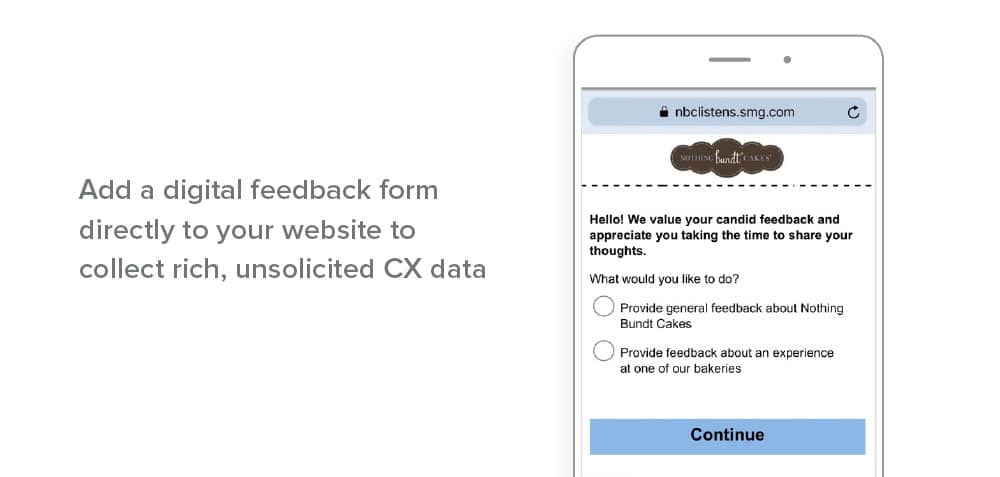How to Strengthen Problem Resolution with Always-on Feedback
Published on Sep 14, 2022

Rapidly shifting behaviors have fast-tracked a new customer experience where digital engagement is part of almost every customer journey with your brand.
But consumer preference for convenient, self-serve options isn’t just about how they choose to do business with you—it’s also about how they wish to leave feedback on their experience, or more specifically, communicate any issues they had during that experience.
For a long time, brands have leaned on contact centers to field those cases. But as consumer demand for digital interaction continues to advance, brands should consider providing customers with another option—one that is quick, convenient, and available 24/7.
Adding an always-on digital listening touchpoint to your customer experience (CX) strategy is beneficial for several reasons. 1) It provides customers with an immediate outlet to voice their issues; 2) It reduces the volume of calls to your contact center, saving your brand money; and 3) It sets up a more efficient and holistic close-the-loop process across the organization.
In this blog, we’ll dig a little deeper into these benefits and provide you with best practices for implementing digital listening touchpoints—including what features to look for and how to successfully integrate + optimize always-on feedback into your existing problem resolution efforts.
Improve customer satisfaction by providing an always-on feedback option
Every interaction with your brand is crucial to consumer perception and future intent. But not every interaction ends with a CX survey, meaning you could be missing out on valuable input. By adding an always-on feedback option you can collect this unsolicited feedback, allowing you to:
- Hear from customers on their terms with this 24/7 format
- Integrate reporting with other CX channels
- Stay on top of issues at the brand + location levels with comprehensive case management
Most consumers turn to your website when they want to share something with your brand—whether it’s a brand-level question or a location-specific issue you might not have considered.
Providing a digital feedback form (like the one shown below) directly on your site provides customers with a simple, intuitive outlet—giving you real-time insight into the customer experience in the moment they are willing to voice their thoughts.

Leverage digital listening posts to improve contact center operations
Though customer preference continues to aggressively lean more toward digital options, we’re not here to advocate for the removal of contact centers. It’s important to note digital isn’t always the best method.
Recent SMG research on consumer trends shows a significant part of the population preferring human interaction over digital options (this is especially true with customers over the age of 55). Beyond that, there are some customer issues that just can’t be resolved through a form and require a proper two-way conversation.
But the reality is, contact centers can be a pricey operation—especially for brands using a third-party service. And call agents are often under a lot of stress, making it more difficult for them to do their job well which can lead to even more customer dissatisfaction. Anything your brand can do to lessen your contact center’s call volume would be beneficial.
Adding a digital listening touchpoint is one of the most efficient ways to take the pressure off. This not only saves you money in the long run, but it alleviates stress on your call agents and gives them space to handle the most pressing customer cases more effectively.
Create an integrated, holistic approach to problem resolution
With the right strategy—and the right CX partner—you’ll have the capability to sync all your feedback channels into one centralized platform. While there are numerous advantages to this holistic approach to case management, we’re going to focus on the top three:
1. Centralized reporting across all channels
Customer issues aren’t restricted to any one channel—and your ability to respond efficiently and effectively is critical no matter the source. Whether it’s a comment left on your website or issues captured through your contact center, you need an all-inclusive, multi-sourced hub of customer feedback, so you can streamline issues and identify common themes across the business.
In addition to seeing open-ended responses across channels, you’ll be able to run the comments through the same robust text analytics engine. With this streamlined analysis, you can break down cross-channel comments by sentiment and turn the qualitative insights into actionable, quantitative data. And that makes it easier for you to get to quicker, more efficient insights—across your business.
2. Alerts sent to appropriate members of your staff
With an alerting system, you can notify managers in your organization when customer feedback needs to be addressed right away. And you’re able to track all of these hot issues—no matter the source—in one place. That means a more complete and efficient close-the-loop process for celebrating exceptional service or responding promptly to issues.
3. Create a unified front across the organization
Obviously the main benefit of successfully resolving a customer issue is pleasing the customer. But a secondary perk is gaining transparency into your service recovery efforts. This gives you a clearer picture of where your brand is succeeding and where your efforts should be directed. Do your employees need to work on quicker response times? Or is there a gap in communication where actions are falling through the cracks?
Pull stats to share with your team members and drive engagement across your organization. Take this opportunity to learn from successes and shortcomings, and drum up excitement to improve.
Improve business outcomes with a stronger problem resolution strategy
82% of customers report that having their issues responded to quickly is the number one factor of a great customer experience. And 84% of customers who are highly satisfied with their problem resolution express a high likelihood to return to the business where the issue occurred.
Meaning: Problems can actually be a great opportunity to gain customer loyalty and drive repeat business.
You have to give customers the chance to voice their problems. But if those problems are primarily being handled by an external contact center, you’re likely spending too much money and missing valuable insight from your more digital-forward customer. Additionally, you’re wasting agent time and effort on a great deal of customer issues that could be better addressed through self-serve digital channels—freeing up those agents to spend time on customer cases that require a higher touch.
Adding digital listening posts and setting up a multi-channel problem resolution strategy may seem complicated but with the right support, it’s actually a very seamless process. Partnering with an experience management (XM) provider is the best way to take the heavy lifting off your team and start seeing results fast.
To learn more about the financial gains of a holistic XM program that provides real-time feedback, check out: The ultimate guide to experience management ROI.
Related articles

Customer feedback analysis: Using AI text analytics to turn comments into action
Are you getting the most out of your customer feedback data? AI-native text analytics helps brands make informed decisions and create better business outcomes.

How to Incentivize Feedback for Your Customer Experience Management Program
Great insights start with great feedback—and great feedback depends on a healthy sample of responses. But as much as we’d love for customers to offer abundant, thorough, and honest feedback purely out

4 Restaurant Industry Trends We'll See in 2022 and What to Do
Restaurant industry trends took a turn during the pandemic and many changes are here to stay. Here are our predictions for the upcoming year.